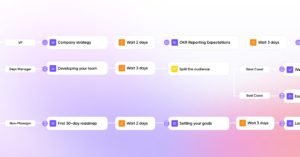Flexible work, hybrid work, remote work—they may each have their distinctive meaning, but generally, they all mean the same thing: employees who work remotely, not necessarily all together in a corporate office.
The technology available that enables a growing remote workforce has changed how (and where… and when… ) we all do our jobs, and most workers feel it has only improved their employee experience. While one can always find a statistic of some kind to back up an opinion, it’s very clear that remote work is not only popular with the majority of people but that it’s also here to stay.
There’s no escaping it; organizations need to be ready to fully support the future of work. To understand who is working where and what they will expect from employers in the future, we gathered some interesting statistics on remote work.
- 72 percent of employees say that their organization is planning ahead for permanent remote work
- By 2025, it’s expected that 36.2 million Americans will work remotely
- Younger workers are more likely than older workers to have remote work opportunities
- According to research by Owl Labs and Global Workplace Analytics, 74% of employees feel happier when they work remotely.
- 60% of workers say they are more productive working remotely than they were in the office.
- 58% of Americans report having the opportunity to work from home at least one day a week. (That’s approximately 92 million people.)
- 33% of workers would quit their job if they were no longer allowed/encouraged to work remotely
- 62% of workers want to be able to choose their work location.
How are executives thinking about improving the quality of conversation around remote work?
- 70% of survey respondents said working remotely every day would have a positive impact on their mental health.
- 24% of workers say being able to work remotely is so important they would take a 10-20% pay cut to continue doing so.
- 87% of employees take advantage of the opportunity to do remote work
- Nearly 100% of employees who work remotely hope to continue working remotely until they retire.
- A McKinsey report revealed that employees who received detailed communications from employers were five times more likely to be productive.
Research report: 5 steps to achieving communication satisfaction with remote workers
- Stanford University found that having employees working from home increased business productivity by 13 percent when compared to the previous year
- There is research that shows businesses lose $600 billion a year due to workplace distractions and that remote workers are 40% more productive than their in-office coworkers.
- 50% of employers believe remote work reduces absenteeism.
- Employees who work remotely tend to work 10% longer than their office counterparts.
Conclusion
If you were to visit some of the most popular job boards, you would see that opportunities to work remotely—or, at least, in a hybrid situation—are plentiful. There is a lot for job seekers to pick and choose from. Remote work is not going away, and it’s not only because employees have discovered they prefer it. Leadership has realized this as well, as they have seen productivity and profits rise as a result.
80% of workers in the United States would turn down a job that didn’t offer some flexible or remote work. Is your organization ready to support these job seekers and the future of work?
Firstup is the intelligent communication platform that connects the employee experience ecosystem, personalizes communications, and improves employee productivity and retention while keeping your remote, dispersed workforce informed and engaged. Reduce the digital noise, create more meaningful communication, and understand your employees better.
Download PDF








